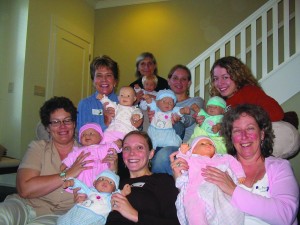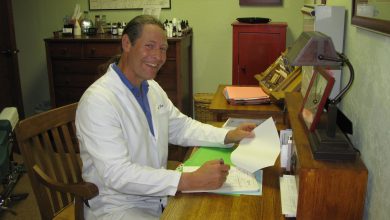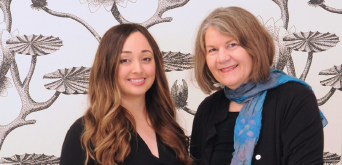Infant Massage with JoAnn Lewis LMT, CEIM Trainer
JoAnn Lewis, LMT, CEIM Trainer is a massage therapist and infant massage educator and trainer who teaches parent/baby massage classes privately and at Ashland Community Hospital. As one of 12 USA certified trainers, she gives educator trainings in the Pacific NW states and other areas of the country.
JoAnn is currently a therapist at the Phoenix Day Spa in Ashland and is teaching private and small group classes for couples, pregnant couples, parent/baby and family massage.
With a strong committment to bring simple massage learning into the daily life of families, JoAnn traces learning this from her mother who gave her back and leg rubs especially after long summers of farmwork. “Even a short massage made such a difference each day in my strength to do the hard work of detassling corn, row after row on the farm and later in life, I realized the deeper bond of love and appreciation it gave me for my mother.” she remembers, “and now in her 80’s, she likes me to give her massages, too!”
Where can people learn more about infant massage and how have you personally been involved in helping infant massage get more established around the world?
Our Southern Oregon Certified Educators of Infant Massage are listed under the connections box on www.southernoregonbirthconnections.com for parents to find an infant massage class in their area. Contact them to register for classes and in Ashland there are classes each month at Ashland Community Hospital Birth Center, call 541-201-4210 to register there.
The USA chapter website at www.infantmassagusa.org is a great resource for national information on health benefits, and for finding parent/baby class instructors by state, trainings for instructors and links to medical updates and with the International Association of Infant Massage, hq Sweden at www.iaim.net for worldwide learning. Infant Massage USA is the official chapter of the International Assoc. now teaching in over 40 countries worldwide.
When I became an International Trainer with this unique organization, I was living in Belgium for 14 months and had the opportunity to mentor under trainers from Sweden, UK, Canada and the USA. It was an extraordinary experience which I feel very fortunate to be able to bring to our communities in the Pacific NW and other states after coming home in 2006.
What has inspired you to become involved with teaching infant massage around the world?
For me, it began with my son who had colic and a lovely midwife showed me how to relieve that condition with a few simple strokes. With both my children, I learned from them how this simple, nurturing touch of massage improved their health and sense of well-being in the world. In my own little world, I realized like many mothers, that this meant the same thing for all the world, a place of peace and caring well for one another with more sleep and less crying. So it made sense to me that this was a necessary part of life to create peaceful societies, too.
After doing more research about massage, I finished massage school, became a licensed massage therapist for 13 years now, and learned as much as I could for all ages and conditions. In 1997, when I found there were others, like Vimala McClure, the founder who wrote the first textbook called, Infant Massage, a handbook for Loving Parents, I was amazed and inspired to find an entire international organization growing rapidly in so many other countries! So, I leaped at the chance to become involved in what I realized was the first and most fundamental family tradition of strong communication through nurturing touch and I have seen the incredible changes for peace it has created firsthand!
Can you tell us a little bit about the history of infant massage?
For centuries and today, people live in tribes and groups where women hold babies next to them in slings and packs and touch is constant. Every member of the village has a role in the survival of the people and helps to care for the babies. Infant massage is thought to have been handed down from mothers to daughters before recorded history as it has been recorded history in medical journals and books since ancient Greece. Infant massage exists as a common practice among the oldest cultures in the world today from Australia to India to Sweden. Hippocrates, the father of medicine wrote: “The physician must be experienced in many things but assuredly in rubbing…For rubbing can bind a joint that is too loose and loosen a joint that is too rigid.” Doctors and nurses in Europe and Asia are still largely trained in massage and teaching infant massage more with our International Association.
How might infant massage help with postpartum depression and or colic?
As the parent massages their baby, oxytocin, relaxin and other hormones are released in both their bodies which relieves depression naturally. With colic, the tummy strokes relieve the congestion and gas commonly associated with colic and again the hormonal and muscle tension releases can aid other discomforts.
What are some of the benefits to babies and mothers who give and receive infant massage?
In addition to the physical benefits, massage can help babies sleep longer and deeper and so, parents sleep better, too. Massage promotes 2-way communication skills, bonding and secure attachment, respect and love. Trust is the main psychological foundation of the first year of life that infant massage builds between the members of a family. It builds confidence and self-esteem for parents and babies and healthy bodies to improve nerve, respiratory, digestive, muscular functions and all physical systems.
How old should the baby be to get a massage?
Massage can start in the first moments of life, gentle little rubs just as the fluids and movements massaged the baby constantly in the mother’s womb. It can build communication skill and understanding from the very beginning. Most parents are ready to take a class after the first few weeks or maybe months depending on the baby. Traditionally, it is good to learn as soon as possible to become part of daily routine, easy and responsive to baby. Massage can be learned at any time though classes for infants are usually from birth to one year before babies become mobile and want to move around to visit with everyone during class!
Can you describe some simple techniques that a reader could practice at home with their baby?
We teach about simple still touch which means placing your relaxed, warm hands on the baby and remaining calm and relaxed; helping everyone to relax. Also, we watch baby’s cues for permission and their body language that tells us if they are ready for a massage. Touch relaxation is a common kind of technique that follows still touch with a positive response of soft words, sounds, smiles, and looks that
Can you share a little bit about how massage allows parents to work with a baby so that it’s not a struggle?
In following the body language, massage becomes an elegant dance of life, of caring and love with respect to the entire person. Babies tell us in one way or another exactly what they want, by a certain movement, cry or sound for each thing until they learn whatever language we speak. When we learn their first language of touch and they learn ours in the exchange of massage, it creates a lasting bond and connection for life. I have watched families who are then able to understand each other on a deeper, easier level for all behaviors, emotions and needs even through the terrible twos or threes or teens!
Can you share a little bit more about parents becoming aware of a babies q’s ?
Many times after learning massage, a parent has turned to me with a look of amazement or even stunned and proudly said, “I knew what he/she (baby) was trying to tell me!” That makes my day!
After even a few weeks of practice, they come back each week of class and tell me what they noticed, when baby’s behavior state tells them they are ready for the massage or something else, when baby was done with just one part of the massage or wanted the whole routine and how they knew it. It’s so great to watch their learning about each other so well.
What does it mean for a baby to be engaged?
When a baby is in their quiet, alert state which, depending on their age in weeks can be short and/or many times a day, they can relax easier than when they are actively exploring things. This state shows us that they are ready to learn massage and when they are engaged they show us by eye contact, open body language and cooing sounds often, too.
Share a little bit about babies crying and massage?
It is well researched in medical institutions that when babies under six months of age are picked up within 90 seconds of beginning to cry, they cry less in intensity and for less time which actually protects their heart health from too much stress. Crying is often the only way they have to tell us something is wrong when their basic need of relieving some discomfort is not being met. This discomfort may be more than physical needs but emotional stress and tension after too many physical discomforts throughout the day have overwhelmed them. Not so different from adults, massage can relieve both physical and emotional stresses at the same time for us and for them.
You also established an Infant Massage chapter in Belgium, can you share a little bit about this?
While I was living there in 2004, and with the visiting Canadian trainer’s list of certified instructors, I organized the initial meetings to bring them together. We put our heads and hearts together and after two meetings, eleven lovely Belgian infant massage instructors filed for a non-profit association status with their government and began the Association Belge de Massage pour Bebe, french speaking chapter now 100 plus members strong of the International Association. Our USA chapter of this Int’l Assoc. follows the same purpose: “to promote nurturing touch and communication through training, education and research so that parents, caregivers and children are loved, valued and respected throughout the world community.”
Please share a little bit about your involvement with the North Medford High School teen parent program?
One of the students contacted me last fall about doing her senior project on infant massage. She and another student parent organized classes that I have been teaching at their CDC, child development center with teen parents and their babies which is the most progressive program supporting students parenting education that I have ever seen. Her hope is to continue the infant massage program as part of their training to improve parenting skills for their future. I have offered her a scholarship to become a certified infant massage educator at the next training in Ashland in March.
Any last thoughts you would like to share with our readers?
Many great people in our world have spoken of knowledge as power, of the importance of applied education. I can’t think of anything more important than learning how our human body works and communicating health by touch with nurturing massage. We are so much more than any of the machines we can make or use and I appreciate this everyday that I am learning about staying in touch with our amazing humanity. I am especially grateful to all the teachers I have learned from, especially the babies!
Conclusion: Please list any credits, or closing statements, websites, phone numbers or emails.
The next Infant Massage USA Educator certification training in Ashland is March 25, 26, 27 & 28 and is open to anyone over 18 yrs of age who wants to teach parent/baby massage classes. Infant Massage USA trains most of our country’s staff persons at Early Head Start, Healthy Start, Parents as Teachers, and other social/educational programs, public and private school teachers, LMTS, Nurses in OB, NICU, Doctors, OTs, PTs, grandparents and foster parents to name a few. This program qualifies many medical professions with continuing education credit hours for their licensing requirements.
Contact JoAnn Lewis at 541-227-8181 or by email: joann.lewis@infantmassageusa.org for any questions about trainings and other massage classes for families.





